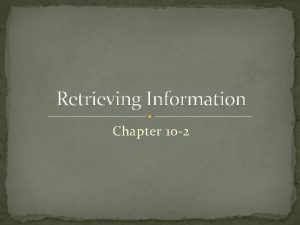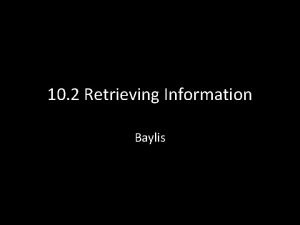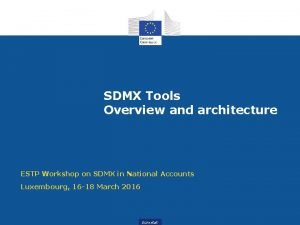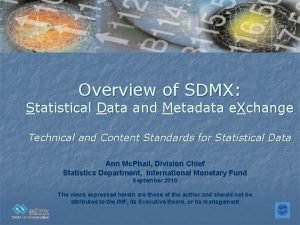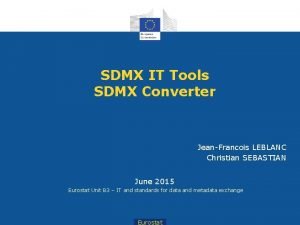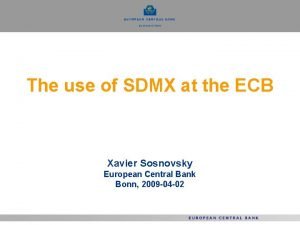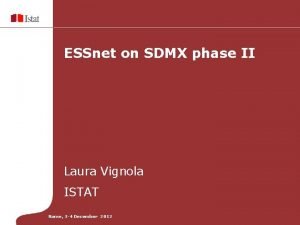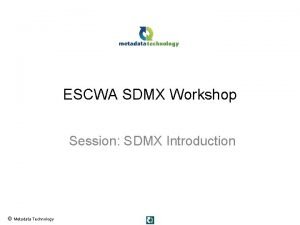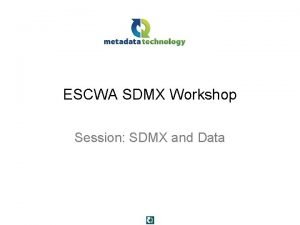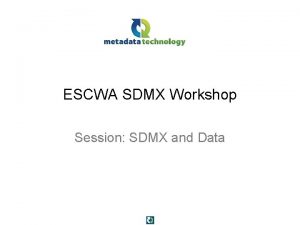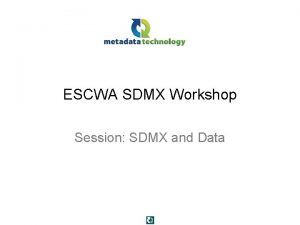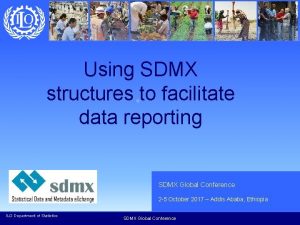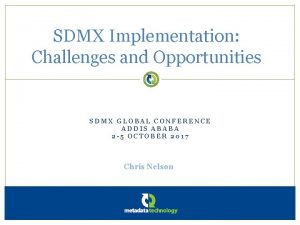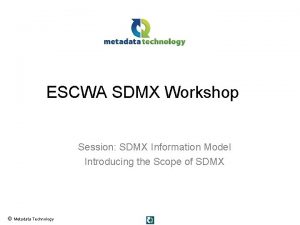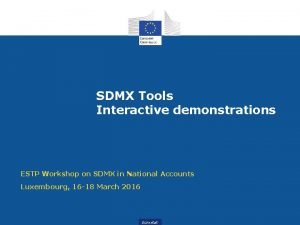Presentation plan Accessing and Retrieving SDMX data Visualising

















- Slides: 17

Presentation plan • Accessing and Retrieving SDMX data • Visualising and analysing SDMX data Excel R and Python Modern BI tools (example with Qlik Sense)

Accessing and Retrieving SDMX data SDMX defines a set of web services to retrieve SDMX objects and data. Available both via SOAP and REST APIs

SDMX REST API – SDMX objects http: //Root. URL/Object. Type/Agency. ID/Object. ID/version • Root. URL: location of the REST API. For Eurostat data, it is http: //ec. europa. eu/eurostat/SDMX/diss-web/rest/ • Object. Type: type of object requested (e. g. dataflow or datastructure) • Agency ID: The maintenance agency for the object requested (e. g. ESTAT) • Object. ID: ID of the object requested • Version: version number of object requested (e. g, 1. 0 or latest)

Example: Retrieving information about Eurostat data Each table in the Eurostat database corresponds to an SDMX Dataflow ID

Example: Retrieving information about Eurostat data Query for retrieving the SDMX dataflow: http: //ec. europa. eu/eurostat/SDMX/dissweb/rest/dataflow/ESTAT/une_rt_m/latest Query for retrieving the corresponding SDMX DSD: http: //ec. europa. eu/eurostat/SDMX/dissweb/rest/datastructure/ESTAT/DSD_une_rt_m /latest

SDMX REST API – SDMX data http: //Root. URL/data/Flow. Ref/Key/parameters • Root. URL: location of the REST API. For Eurostat data, it is http: //ec. europa. eu/eurostat/SDMX/diss-web/rest/ • Flowref: The ID of the desired dataflow • Key: The subset of the data requested, as specified by a key (i. e. a set of values for the dimensions in the DSD). Elements of the key are separated by dots. • Parameters: Optional parameters that can further identify a subset of the data (e. g. startperiod, endperiod or last. NObservations). Parameters are always introduced by a "? " sign and separated by a "&" sign.

Example: Retrieving Eurostat data I want monthly unemployment rate data from Austria from 2010 to 2013 http: //Root. URL/data/Flow. Ref/Key/parameters • Root. URL: http: //ec. europa. eu/eurostat/SDMX/diss-web/rest/ • Flowref: une_rt_m • Key: …. . AT • Parameters: ? startperiod=2015&endperiod=2017

Retrieving SDMX data: caveats In order to correctly input the key parameter, I need to know the correct codes and the correct order of the dimensions. I must look at the DSD! If I do not want to look for a specific key, I can just use "all" instead of the dots SDMX data comes in many formats. The default format for the REST API is the "SDMX Generic format". If I want another format, I need to modify the query header. But for that I need a REST client…

Visualising and Analysing SDMX data SDMX-ML great for data processing. But not great for understanding the data at first glance…

Visualising and Analysing SDMX data Options: • Using the SDMX Converter to convert data from SDMX-ML to CSV • Opening the SDMX-ML file directly with Excel • Taking advantages of analytical libraries for parsing XML data or SDMX-ML data specifically

Using Excel to visualise SDMX-ML • Import the SDMX-ML file directly in Excel. Select the "As XML Table" option and ignore the pop-up warnings. • Excel will flatten the nested SDMX structure. We can then easily build a pivot table to analyse and visualise the data

SDMX data using R or Python • There are SDMX libraries available for both R and Python • These libraries can directly connect to SDMX Web Services import and transform SDMX data into native formats

SDMX data using R or Python • For R, two very good libraries are available: rsdmx and RJSDMX (the latter developed by Banca d'Italia) • • For Python, there is a library called panda. SDMX (with very good online documentation) • These libraries can directly connect to SDMX Web Services import and transform SDMX data into native formats

SDMX data using R • rsdmx can be used to download SDMX objects and SDMX data • • • Advantage: unified and flexible interface (only one method to learn) • • Disadvantage: unified and flexible interface (you need to know what you’re doing)

SDMX data using R • RJSDMX can be used to download SDMX data, but not objects • • • Advantage: “single-minded” approach, less SDMX knowledge expected from users • • Disadvantage: fewer functionalities

SDMX with modern BI tools • All modern BI tools (Tableau, Qlik, Spotfire etc…) have built-in REST connectors and XML parsers • Creating a dashboard based on SDMX data is usually a matter of clicks

Key messages • SDMX data can be retrieved via standardised web services • There are several options to visualise and analyse SDMX data
 10-2 retrieving information answers
10-2 retrieving information answers Vocabulary activity 10-2 retrieving information
Vocabulary activity 10-2 retrieving information Sdmx excel
Sdmx excel Http://sdmx.us:8080
Http://sdmx.us:8080 Sdmx converter
Sdmx converter Ecb sdmx
Ecb sdmx Sdmx istat
Sdmx istat Sdmx converter
Sdmx converter Accessing mainframe data from java
Accessing mainframe data from java Downloading and accessing
Downloading and accessing Accessing i/o devices
Accessing i/o devices Accessing io devices in computer organization
Accessing io devices in computer organization Flipping bits in memory without accessing them
Flipping bits in memory without accessing them Desirable features of distributed file system
Desirable features of distributed file system Accessing input output devices
Accessing input output devices Accessing complex texts
Accessing complex texts Sinciput presentation
Sinciput presentation Leopold's maneuver
Leopold's maneuver
